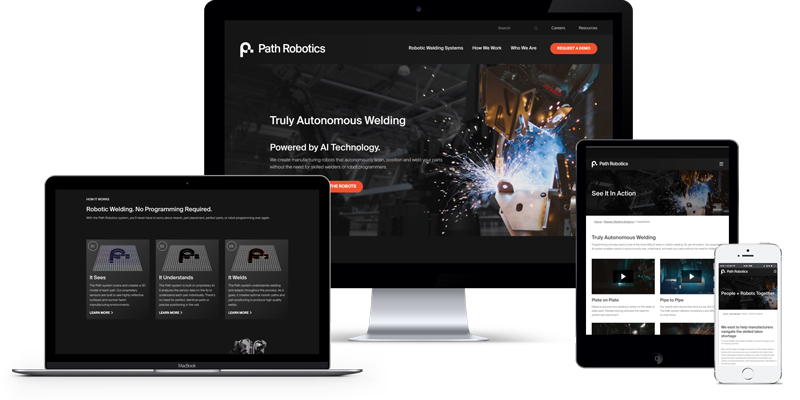Modern Site Style That Catches Attention and Transforms
In an increasingly electronic landscape, modern internet site layout has actually arised as an essential consider recording customer interest and driving conversions. By tactically using aesthetic pecking order, receptive layouts, and engaging interactive components, developers can create experiences that not only draw in site visitors however likewise facilitate meaningful interactions. Reliable call-to-action approaches play a vital duty in guiding individuals toward wanted results. As we explore these essential elements, it ends up being clear that comprehending their interplay can significantly affect a website's performance and customer complete satisfaction. What are the crucial elements that genuinely make a distinction?
Value of Visual Hierarchy
Aesthetic hierarchy is an important aspect in site style, as it overviews customers' interest and boosts their total experience. By strategically arranging material, developers can route customers to the most crucial info initially, thereby boosting interaction and enhancing usability.
Including a rational flow in content setup is necessary; for instance, placing the most important information at the top of a page fosters immediate acknowledgment. Furthermore, consistent use typography, such as differing font dimensions and styles, assists establish a clear web content framework. This organization not only help in navigation yet likewise develops trust fund, as users feel more comfortable when they can conveniently discover what they are searching for.
Ultimately, a well-executed visual power structure not just improves aesthetic allure however also considerably influences individual actions. By focusing on crucial aspects and making sure a seamless experience, developers can effectively convert visitors into clients, enhancing the significance of this foundational design principle in modern internet site growth.
Responsive Design for All Devices
Producing a seamless experience throughout numerous tools is crucial in today's electronic landscape, where customers access internet sites from tablet computers, mobile phones, and desktops alike. Receptive design is an important strategy that makes sure web sites adjust fluidly to different display resolutions, sizes, and alignments. By using flexible grids, photos, and CSS media questions, developers can produce designs that maintain aesthetic honesty and performance, no matter the gadget being used.
The significance of receptive design extends past aesthetic appeals; it straight impacts user involvement and conversion rates. An internet site that operates well on all gadgets encourages longer brows through and reduces bounce prices, as customers are more probable to communicate with web content that is easy to navigate. Search engines, especially Google, prioritize mobile-friendly sites in their rankings, making receptive style an important component of search engine optimization (SEO)
Integrating responsive style not only improves individual experience yet likewise streamlines the development procedure. By creating a solitary site that functions across tools, services can save time and resources compared to establishing different mobile and desktop variations. Ultimately, receptive layout is an essential approach for modern-day internet site layout, ensuring access and complete satisfaction for all individuals, regardless of their tool.
Involving Interactive Components
While a responsive style lays the groundwork for a useful site, including interesting interactive components is essential for recording individual focus and promoting deeper connections. Website Design. Interactive components, such as animations, tests, and clickable infographics, produce a more vibrant user experience, encouraging visitors to invest more time on the site
Including interactive features can additionally lead individuals with complicated info, making it simpler to digest material. Interactive sliders can highlight item variants, while embedded videos can give presentations or endorsements that reverberate even more than fixed images or text. Gamification strategies, like benefits for involving or completing tasks with content, can enhance user inspiration and retention.
Reliable usage of interactive components not only enriches the customer experience however can also lead to higher conversion rates. It is vital to stabilize interactivity with efficiency; excessively complicated attributes may hinder website speed, negatively influencing user contentment.
Streamlined Navigation Practices
Reliable navigating is a foundation of any kind of successful site, as it straight affects customer experience and material availability. Streamlined navigating methods make sure that users can conveniently locate info, improving their communication with the website. A well-structured navigation food selection should be intuitive and easy, normally including a minimal number of key categories to avoid frustrating site visitors.
To attain streamlined navigation, developers must focus on a hierarchical framework that realistically arranges content. Applying breadcrumb trails can offer individuals with context concerning their present area within the website, permitting for seamless backtracking. Additionally, using drop-down menus can successfully conserve room while still providing access to subcategories.
Responsive style is crucial, as navigating ought to be practical throughout all gadgets (Website Design). Mobile individuals, in certain, benefit from touch-friendly food selections and collapsible areas that maintain usability without jeopardizing appearances

Reliable Call-to-Action Techniques
A well-crafted call-to-action (CTA) is essential for assisting customers toward wanted end results on a website, as it motivates them to involve with web content or purchase. To maximize their efficiency, CTAs ought to be clear, click for more info engaging, and purposefully put throughout the site.
First, use action-oriented language that connects seriousness or value, such as "Start," "Sign up with Currently," or "Claim Your Discount rate." This language not just inspires individuals however additionally sets clear expectations concerning the following actions.
2nd, take into consideration style elements; CTAs need to stand apart aesthetically via contrasting shades, enough whitespace, and famous positioning. A switch that is simple to see and click rises the probability of customer interaction.
In addition, personalizing CTAs based on individual habits or demographics can substantially improve involvement. Customized messages reverberate extra with customers, driving greater conversion prices.

Verdict
These elements collectively enhance individual experience, ensuring that visitors continue to be involved and encouraged to explore material even more. By focusing on these design principles, businesses can considerably enhance customer retention and conversion prices, ultimately leading to higher success in the electronic landscape.
In an increasingly he has a good point electronic landscape, contemporary internet site design has emerged as a crucial factor in recording user attention and driving conversions.Aesthetic hierarchy is a vital aspect in website design, as it guides customers' interest and improves their overall experience.The significance of receptive design extends past aesthetic appeals; it directly impacts customer engagement and conversion prices.Incorporating responsive layout not just enhances customer from this source experience however additionally improves the development process. Eventually, responsive layout is a fundamental method for contemporary site style, making certain ease of access and contentment for all users, regardless of their tool.